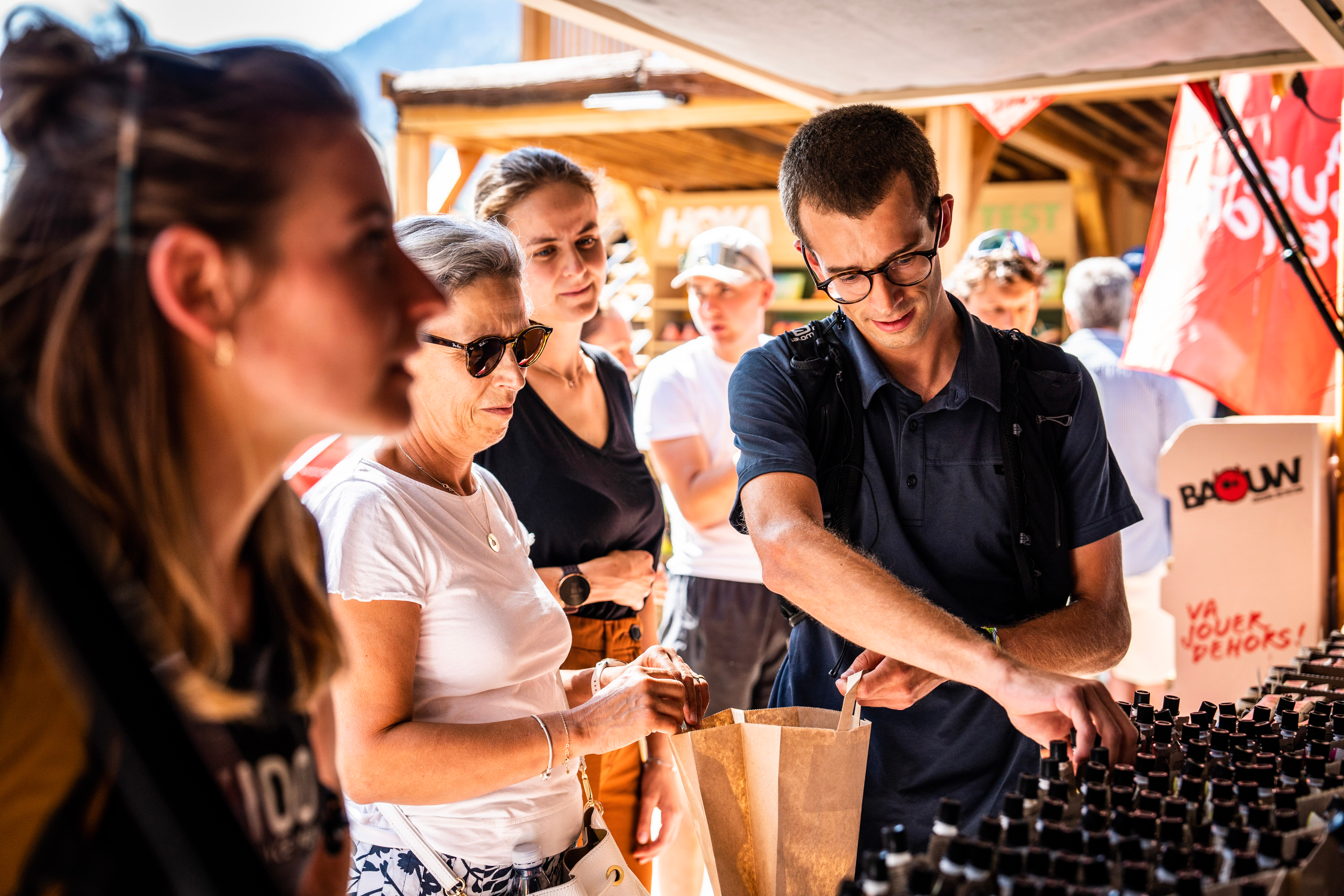
1. Background to the project
The project, launched last March, involved around ten Baouw athletes as well as a few members of our team, in order to benefit from results that included all types of sportsmen and women. These athletes have been closely monitored by our innovation team and our nutritionist Benoit Nave. The aim is to support them in an overall approach to health and performance. The study lasted 1 month and included monitoring during exercise (training or competition), as well as on a daily basis (sleep, meals, etc.). Our athletes consumed our Baouw products to see their impact on their bodies, but they also agreed to play the game with equivalent products from some of our direct competitors.
Each participant wore a continuous glucose sensor supplied by Supersapiens, enabling precise daily monitoring of blood sugar levels. This device measures blood sugar levels in real time, providing essential data for understanding how different dietary interventions impact blood sugar stability.
This technology has therefore enabled Baouw to assess the effect of its products on blood sugar levels, and also to compare the results with those of its competitors.
2. Graphical analysis
The graphs below are constructed as follows:
- X-axis: duration of effort in hours.
- Y-axis: blood carbohydrate levels.
Une glycémie stable et maîtrisée se situe entre 90 et 140 mg/dL sur l’échelle des ordonnées. Dépasser ces seuils est synonyme d’hypoglycémie (< 90) ou d’hyperglycémie (>140). Sortir de ce seuil signifie donc sortir de sa zone de performance optimale et risquer d'impacter sa santé.
Cas N°1
Type of outing: Trail - Hill session with intensity of around 1h30.
Nutrition: The athlete consumed a Baouw compote (12g of carbohydrates) after 15 minutes of effort, then 2 Baouw natural gels, each containing 30g of carbohydrates, continuously in small doses for the rest of the effort, for a total of 72g of carbohydrates over the run.
Analysis: He consumed only Baouw products and did not experience any hypoglycaemia or hyperglycaemia. He was able to keep his blood sugar levels stable and under control despite a slight drop at the end of the outing.
Case N°2
Type of outing: Cycling outing of around 2h30, start at 11h30, finish at 14h.
He consumed a Baouw bar (30g of carbohydrates) after 1h of effort and a second bar 45mins later for a total of 60g of carbohydrates over the two hours.
Analysis: He consumed only Baouw products and experienced no hypoglycemia or hyperglycemia. He was able to keep his blood sugar levels stable and under control.
Case N°3
Type of outing: 4h trail run, start at 4pm, finish at 8pm.
Nutrition: The athlete consumed 5 Baouw gels containing 30g of carbohydrates, i.e. 150g of carbohydrates over 4 hours of effort.
Analysis: He experienced hyperglycemia at the start of the effort, probably due to his pre-race diet. This resulted in reactive hypoglycemia. Consumption of an initial Baouw gel (30g carbohydrate) enabled him to return to the ideal blood sugar threshold, before gradually stabilizing with regular gel consumption (1 gel every 30min).
Case N°4
Type of outing: Long trail run, start at 10:30, finish at 17:30.
Nutrition: The athlete varied his consumption of Baouw products with products from 3 competing brands. All gels were taken in similar quantities, i.e. a dose of around 30g of carbohydrate per intake.
Analysis: It's interesting to note that the exercise was carried out within the same session, and therefore under identical conditions for Baouw and competitor products. We can see that during the 1st part of the run, the athlete maintained stable blood sugar levels and smooth energy levels without any slack periods.
On the other hand, as soon as the athlete started using processed gels based on low-quality maltodextrin and glucose syrup, blood sugar levels were no longer under control, and periods of “yo-yoing” between hyperglycemia and hypoglycemia followed.
3. Project results
The test results were revealing. With exclusive consumption of Baouw products during exercise, athletes showed controlled blood sugar levels and continuous energy without any reactive hypoglycemia, otherwise known as “sluggishness”. In comparison, the use of competing products often resulted in more marked variations in blood glucose levels, including spikes followed by abrupt drops.
Les produits Baouw, conçus à partir d’ingrédients bruts à indice glycémique (IG) bas, ainsi que des bons lipides, ont prouvé leur efficacité pour maintenir une glycémie stable. Ces ingrédients permettent un apport énergétique soutenu et progressif, évitant les fluctuations brusques de la glycémie.

4. In practical terms, what's the point of keeping your blood sugar levels under control?
Quite simply, to improve your short-term performance during exercise and preserve your long-term health!
To fully understand the results of our project, it's important to know what blood glucose levels mean during exercise and the impact of hyperglycemia (high blood glucose) or hypoglycemia (low blood glucose).
- Normal blood glucose: Blood glucose levels considered normal for exercise are generally between 90 and 140 mg/dL. Maintaining blood glucose levels within this range is crucial to avoid the harmful effects of excessive fluctuations.
- Hyperglycémie : Une glycémie supérieure à 140 mg/dL à l’effort est une hyperglycémie. À long terme, des niveaux élevés de glucose dans le sang peuvent entraîner des complications comme la fatigue, une diminution de la performance et des problèmes de santé par la suite.
- Hypoglycemia: Blood glucose levels below 90 mg/dL during exercise are indicative of hypoglycemia. Symptoms include weakness, dizziness, tremors and, in extreme cases, loss of consciousness.
Baouw is committed to continuing to develop high-quality products, based on sound scientific data, to support athletes in their quest for performance and well-being. We are convinced that nutrition is a fundamental pillar of sports performance, and we are proud to be able to offer products that meet these requirements.
5. Bonus / Further information :
Supersapiens technology explained
To better understand the context of this study, let's first look at the technology used. Supersapiens uses Abbott's Libre Sense Glucose Sport sensor, a continuous glucose monitoring device. This sensor is placed on the skin and measures interstitial glucose every minute, providing real-time data via a mobile app. This technology enables immediate detection of variations in blood glucose levels, providing an in-depth understanding of the body's reactions to different foods and physical exertions.
*This project is an in-house study, not a full-fledged scientific study. Reactive hypoglycemia, for example, has not yet been scientifically proven, but was observed during our study.
©ColinOlivero







